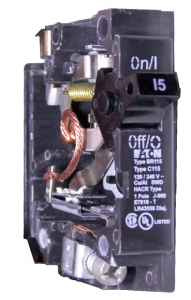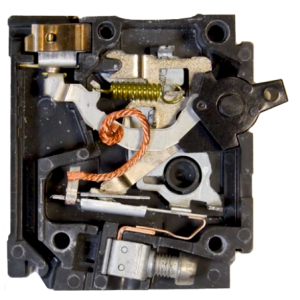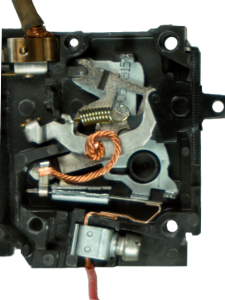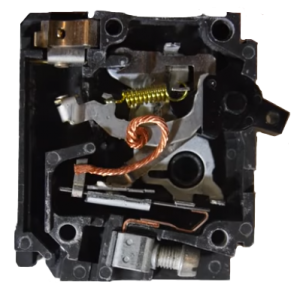Circuit breakers are safety devices that interrupt the flow of current. This happens if there’s either a gradual increase in load or a short circuit, which trips the breaker instantly. The most common times for a breaker to trip in a household are when devices which convert electrical energy to heat are in use. Examples would be an electric stove, heater or hair dryer. Electric motors, such as those in air conditioners or pool pumps can also cause frequent trips. When devices like these turn on there is a spike in electrical demand. If the circuit powering these devices is not able to handle that spike it will likely trip the circuit breaker. The purpose of having a circuit breaker is to prevent fire from happening in the first place.
Circuit Breaker Internal Components
In order to dive into how circuit breakers work, we need to know what type of parts they have. Not all circuit breakers have the same exact parts but for the most part they have very similar anatomy and function. Here are the basics and main components of a breaker:
Contacts
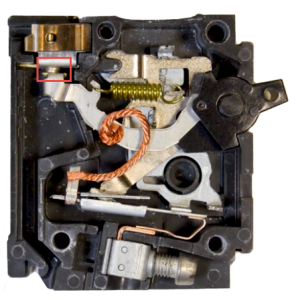

These are two independent pieces of metal. One contact is attached to one end of the actuator mechanism. The other contact is attached to a metal part where wires would connect to the main breaker panel / bus bar (line side). They allow current to flow through when they are in contact with each other (touching). Conversely, they break current flow when they are moved apart from each other and not in contact (not touching).
Actuator Mechanism
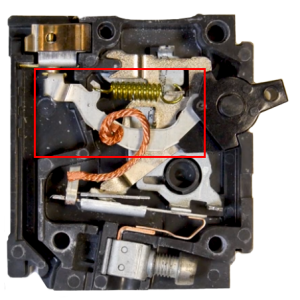
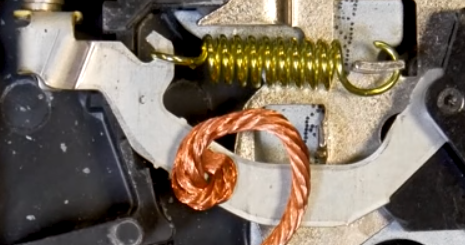
This mechanism is a metal arm that is connected to a few other parts of the breaker system. The essential objective of the actuator mechanism is to force the contacts together or apart when the breaker trips. One end attaches to the lever and the other end has a contact attached to it. This contact touches the other contact (explained above) when the lever is on. The contacts disengage when the breaker is tripped or off.
Thermal Magnetic (Bi-Metallic strip) Trip
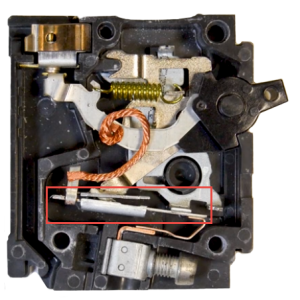

The thermal magnetic trip is a bi-metallic strip that forces the contacts together or apart. There are two mechanisms in play on this trip: thermal and magnetic trips. The thermal unit is for gradual over current situations (like an overload). It provides long time delay for light overloads and fast response for heavy overloads due to the bi-metallic strip is being dependent on current and time. On the other hand, the magnetic device is for situations that need to be interrupted immediately (like a short circuit). Thermal magnetic trip is commonly found in many circuit breakers. However, other breakers have different mechanisms to detect change in current flow. These are magnetic trip, thermal trip, and electronic trip, which we won’t get into here. But the main difference is how they trip the breaker.
Terminal
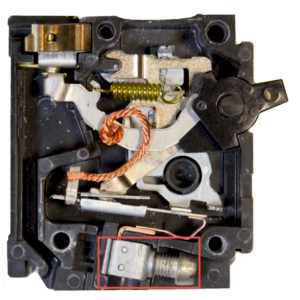
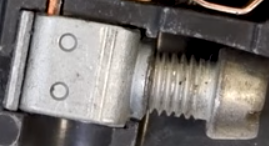
The terminal is another metal block that protrudes out as a bolt. It connects to load (wire connections) like receptacles where appliances are plugged in. You normally hear this as load side terminals or load side lug terminals.
Lever
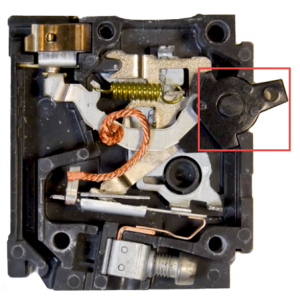
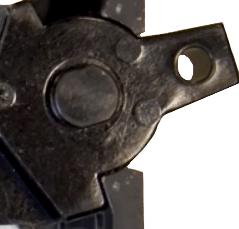
Last but not least is the lever. It is used to turn the circuit breaker on, off, or middle when the breaker trips. When the breaker is “on”, the contacts are touching and current is flowing. If the breaker trips, the contacts disengage and the breaker turns to the middle position. To reset the breaker, you have to turn it off to put the parts in their proper place then back on to lock the parts in place.
Household Fault Scenarios
There are two types of household fault scenarios: overload (slow blow) and short circuit.
An overload is when the current draw of the load exceeds the amperage rating of the circuit rating. For example, when too many appliances are running on one outlet.
A short circuit is when current flows in a path that’s not that normal path. For example, a direct short or phase-to-phase short or phase-to-ground (ground fault). When two hot wire, or one hot wire carrying a current and a neutral wire, accidentally touch each other. The result is too much current in a short period of time.
In both cases, the household circuit breaker trips because there’s too much current flowing through the thermal magnetic strip. This creates heat and heats up the strip. Too much heat changes the thermal magnetic strip’s shape. The shape then changes to the point where it releases the lever, trips the circuit breaker, and interrupts the circuit.
Right before the trip, there may be some sparks and you may hear a pop. You may also smell plastic burning from the heat. Circuit breakers are great but they aren’t always fast enough to prevent life threatening situations. The best way to protect yourself and your residence from hazards, such electrocution or fire, is by replacing your breakers with ground fault circuit interrupter (GFCI) or arc fault circuit interrupter (AFCI) breakers. Circuit interrupters are meant to immediately stop current flow through a circuit and prevent shock and fire from happening.
Conclusion
There are different types of circuit breakers but they all have similar anatomy and functions. The main function of a breaker is to detect the change in current and reacts depending on their trip function. In this case, the thermal magnetic trip detects overload and short circuit that cause fire. However, it is still a good idea to invest in a more advanced type of circuit breakers that are made to prevent fire and shock. These breakers are GFCI and AFCI breakers. A little investment can save you a ton of money in the long run.

